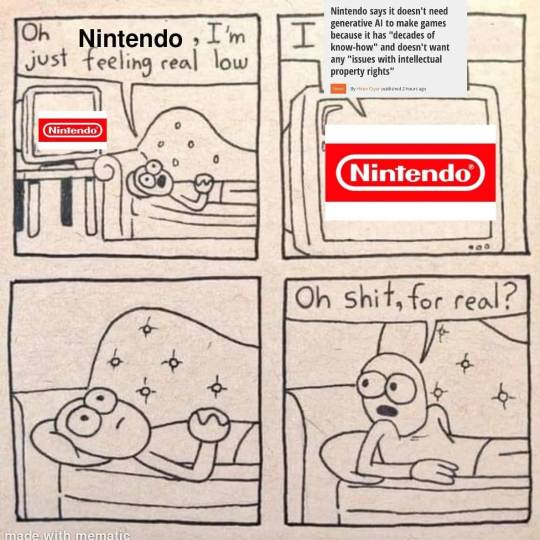#the nintendo subscription service sucks ass
Explore tagged Tumblr posts
Text
completely off topic but regarding something that i saw pop up in my FB feed and i need to rant about

please do not fall for this shit
nintendo is NOT anti-AI.
it's really easy for them to say they're not going to use generative AI to create their games, because this statement has nothing to do with the very real issues with AI art such as the blatant theft of artists' work, environmental impact, replacement of humans in the industry, and just flat out unethical shit that AI has been designed around
it has EVERYTHING to do with their intellectual property rights, which Nintendo is NOTORIOUS for protecting with an iron fist even at their own expense. and i'm not talking the usual sensible argument shit like "ofc Nintendo wants to protect their IP's, they're a business!" i'm talking about the fact that this is the same company that just recently did a major takedown of the vast majority of Nintendo-licensed games on Vimm's Lair which aren't even being sold legitimately anywhere anymore-

i have so many fucking bones to pick with the flaccid bootlicking anti-piracy arguments out there but basically it comes down to this:
Nintendo is not a small indie company. They are literally one of the biggest, richest, most powerful gaming companies on the planet, rivalling Disney in just how many major franchises they own and profit off of. Many of their games are cultural classics, not just through the sentimentality and nostalgia of our childhoods, but also for all the innovations they made through games like Super Mario Bros, Super Mario 64, The Legend of Zelda: Ocarina of Time, and many others that we, within the world of gaming, owe a lot to and should be able to access and play. It's not a matter of "wanting these games for free", it's a matter of wanting to be able to access these games, period, and Nintendo is deadset on making it as difficult as possible, even when it doesn't necessarily profit from them (need I remind you that many of the games that were taken down from Vimm's Lair are NOT available through their shitty, poorly-ported emulation subscription service - plus that subscription service can be altered and/or removed at any time, regardless of what you paid for, just like the Wii Virtual Console was, meaning you do not own any of the games you're paying to play on there.)
This isn't about being "cheap" or "not wanting to pay for games". This is about media preservation and the virtue of actually owning the things we pay for. If these games were resold at official outlets for reduced prices or made more accessible through e-shops that don't close down in between console generations or drip feed the odd legacy title every few months or release crappy ports on their outdated af tech for only a few months at a time for three times the price of their original value, people would gladly pay. It's the fact that people are having to put up with all of the hoops that Nintendo has put in place to prevent them from even handing them money to play their favorite titles that even drives them to piracy to begin with, and Nintendo will gladly shut those sites down to protect their IP even when it's an IP they're no longer profiting from and aren't making active efforts to sell.
Like, I would gladly hand over a reasonable amount of money (i.e. not the cost of a brand new triple A title in 2024 which is like $80-$100 here in Canada) for Diddy Kong Racing on the Switch, but ofc it's not on the fucking online play store and even if it was, I'd have to deal with paying an overpriced subscription fee for a port of the game that would undoubtedly run WORSE than it does on my PC, and that subscription service can be taken down at any time. But Nintendo wants me to not pirate the game that's not available on their shitty subscription service because... just don't do it, pretty please??
youtube
Nintendo is not anti-AI. They would gladly use AI in place of manual labor to scour the internet and dish out DMCA's to every emulation site, archived ROM hub, fan game, and artist alley creator if they could... oh wait, they already are.
Do not fall for the virtues of anti-AI when it comes to companies like Nintendo. They are not anti-AI. They're anti-ownership. They're anti-preservation.
#fuck you nintendo#the nintendo subscription service sucks ass#the games are ported horribly#the fact that the original gamecube can run at 60fps but the switch is locked at 30fps is fucking insane#it's 2024 get with the fucking PROGRAM
173 notes
·
View notes
Text
Case Study #10: Let’s Play

Some Background
Documenting video game play-through is an activity that’s been undertaken by disparate groups more or less since the popular inception of video games.

Probably.
The creation of the specific Let’s Play genre is credited to Something Awful forum user Michael Sawyer, A.K.A. slowbeef, in the mid 2000s. Inspired by a thread wherein screenshots of Oregon Trail gameplay were posted to the forum to provide users the opportunity to collaborate on a play-through of the classic game, slowbeef made the jump from posting game screenshots and commentary on his personal site to the Something Awful forums. He posted these image commentaries, for which he coined the Let’s Play name, until 2007, when he introduced video into the mix. And so, from the loins of slowbeef, a genre was born.
Today, Let’s Play takes the form of recorded or live streamed video wherein a gamer documents and provides commentary on his or her experience playing a video game. Put more simply, remember when you were little and you would go over to David’s house because he was the only one with a Super Nintendo? And then, instead of letting you play Super Star Wars, he just made you sit on the couch and watch him play while he said “let me show you something cool” over and over? It’s that, but in video form.

“Let’s Play” my ass
Let’s Play videos are distinct from walkthroughs or strategy guides in that their primary purpose isn’t to provide information on how to to progress through the game. Instead, they document a gamer’s subjective experience in order to entertain and, as the name implies, attempt to include the viewer. Serialization or live-streaming of play-throughs allows the audience of Let’s Play videos to provide feedback on how the gamer should complete play-through, though this isn’t a necessary component. In many instances, the viewer is simply included through the comment section of the stream or video. The format of Let’s Play videos is relatively loose, but they can take the form of criticism, unique challenges (i.e. complete a game without killing any enemies), or play-throughs of user-made mods to well-known games.
If you don’t spend a lot of time in the world of online video, this might seem like a niche form of entertainment, but it’s important to know that Let’s Play video content is popular. Like, really, really popular. Twitch.tv, a site dedicated to live streaming video game-related content, including a huge chunk of Let’s Play video, sees 45 million unique users per month. Similarly, Let’s Play content is extraordinarily popular on YouTube, with the honor of the most-subscribed creator on the entire platform belonging to Let’s Play superstar Felix Kjellberg, more popularly known by his handle PewDiePie. Kjellberg has more than 50 million subscribers on YouTube, and his videos have seen nearly 14 billion views combined. Framed in YouTube Standard Units, that’s 5 Gangnam Styles worth of views. His annual income from this activity approaches $50 million, which is more than all but the wealthiest professional athletes make. Suck it, jocks.
Oh, and Time magazine named him one of the 100 most influential people in the world in 2016. So, yeah. It’s kind of a big deal.
If you’ve never seen one of these videos, their style could best be described as “millennial as all hell.” Here’s PewDiePie’s most popular video, which as of this writing has surpassed 74 million views. If you can through more than a few minutes of it, congratulations: you’re more patient than I am:
youtube
The Dystopia
Many works of dystopian fiction explore the concept of what entertainment might look like in their imagined societies, often featuring dumbed-down versions of popular media or barely-disguised advertisements that have supplanted other forms of media. As early back as The Time Machine in 1895, H.G. Wells postulated on the decline of literature and the curiosity that inspires its consumption among the childlike an ineffectual Eloi, descendants of humanity who evolved in an environment in which strength and intelligence were no longer required to thrive:
youtube
The irony of presenting the film version rather than a text excerpt is not lost on me.
Similar representations of in-world media, in which content is dumbed-down and designed to promote complacency and consumption, appear in Brave New World, The Marching Morons, THX-1138, and Idiocracy, the latter of which already bears an eerie resemblance to the end-bumper of most YouTube videos:

Criticism of the Let’s Play genre generally follows the same pattern that has characterized criticism of all emergent forms of media throughout modern history. For a pre-internet point of reference, see Neil Postman’s Amusing Ourselves to Death, which directly draws comparisons to Huxley’s Brave New World in criticizing television as a form of media.
Within this vein, criticism of the Let’s Play genre can roughly be categorized as follows:
It’s dumbing down entertainment/it’s reductive: i.e., why would we watch a video of someone playing games that we can play ourselves? A South Park episode featuring the genre, entitled #REHASH, takes this line of criticism.
It’s encouraging sloth/complacency: i.e., Why are we paying people (in some cases) millions of dollars to sit on their asses and play video games?
It encourages further consumption: i.e., plenty of these videos are just thinly-veiled advertisements for the games themselves.
It’s isolating: i.e., Why are we sitting in dark rooms watching these videos alone when we could be gaming socially?
But Why?
While the Let’s Play genre might seem like the shiniest and newest thing in media, both the form itself and the criticism it has inspired are anything but. In reality, Let’s Play is simply the logical product of existing realities within the media landscape.
Watching someone play a game that you yourself could play is nothing new. That idea has been around basically forever, and it exists in what might otherwise be considered the cultural opposite of video games: spectator sports. The only real difference between spectator sports and Let’s Play videos is the type of game being played. In fact, in comparing the two, we can find responses to the criticisms leveled at the latter:
It’s dumbing down/it’s reductive
We can find value in watching someone perform a task we ourselves are capable of because that person might be more skilled or more entertaining than we are. I can play a pickup game of basketball if I want, but it doesn’t compare to watching Steph Curry sink a half-court buzzer beater. Similarly, I can play through Ocarina of Time and enjoy many hours of interesting story and puzzles, but watching an expert beat the game in under 20 minutes is a categorically different experience.
It’s encouraging sloth/complacency
Given the incredibly high spectator to participant ratio, do spectator sports really discourage sloth any more than Lets Play? The chubby guy in the stands or on the couch screaming about his team is such a common sight that it’s practically a trope at this point. Cheering only burns so many calories, after all. Furthermore, we can’t even argue that spectator sports universally promote healthy habits among those few who they do inspire to become athletes. As our pal Fake Malcolm Gladwell so eloquently put it:

It encourages further consumption
Spectator sports are just as laden with advertising as Let’s Play, even if the latter can obfuscate the matter more. Furthermore, advertising provides a means for content creators to earn money, and it’s broadly a good thing that as the economic landscape is changing, new opportunities for individuals to make a living continue to arise. Advertising within the Let’s Play genre is really only dystopian in so far as it approaches content marketing, i.e. disguising an advertisement as the content a viewer is seeking out, rather than explicitly promoting a product in and around the content itself. This becomes even more concerning when considering the relative youth and impressionability of the Let’s Play audience. While the format of Let’s Play videos lends them to content marketing more than does something like spectator sports, this form of advertising is in no way unique to the genre. As a rabbit hole of its own, it bears more complete discussion in a separate post.
It’s isolating
It’s on this final point that spectator sports and Let’s Play diverge most clearly. Spectator sports are still a predominantly social activity, with viewers gathering at stadiums, in sports bars, or in their homes to watch games. While the act of watching Let’s Play videos alone on a computer or phone screen may seem fundamentally less social, the evidence actually suggests that the genre did not arise to promote solitary behavior, but rather to remedy larger isolating forces at play. The rise of Let’s Play videos is directly correlated with something we’ve discussed in previous posts—the death of local multiplayer games. As video games become more graphically intense, consoles have a harder and harder time processing the multiplayer experience on a single screen.
Furthermore, game and console manufacturers have a strong monetary incentive for favoring online multiplayer over local multiplayer. For example, if you and three friends want to play a game locally, that requires the purchase of one console, one copy of the game, and four controllers. If you and the same three friends want to play a game online, that requires the purchase of four consoles, four copies of the game, four controllers, and, in many cases, a monthly online service subscription. Surprise! Once again, the pursuit of profit plays a large role in the most dystopian aspect of this case study.
Redeeming Qualities
Digging into the Let’s Play community in either the form of video comments or forums, it becomes clear that the social nature of the videos is what draws a substantial portion of viewers in, motivated in part by the aforementioned economic strains that modern gaming places on gamers—particularly those who are younger. Playing the latest and greatest games can be a very expensive endeavor, but watching Let’s Play videos is free, absent the cost of an internet connection. Viewers in many cases are unable to play these games themselves, socially or otherwise, but can find in Let’s Play an experience at least somewhat analogous to playing them—and playing them with friends to boot. Beyond that, it’s hard to ignore the generally positive tone of comments on Let’s Play videos, in particular those as unrepentantly positive as PewDiePie’s. In a very real way, watching these videos makes people feel happier and less lonely.
Beyond social benefits and the mitigation of economic strains, Let’s Play democratizes access to games that are otherwise restricted by region or obscurity, particularly old and out-of-print games. A content creator can invest his or her revenue stream in these types of games and allow viewers from around the world to gain insight into what it’s like to actually play them. Similarly, the Let’s Play genre can provide a valuable platform for independent games that might not otherwise be noticed by mainstream game reviewers. Plenty of genuinely interesting and unusual indie games, including Thomas Was Alone and The Stanley Parable have directly attributed their success to positive relationships with Let’s Play channels.
Can We Fix It?
In an unexpected turn of events, after some research and reflection, I think that there’s much more to like about Let’s Play than there is to fear.
Don’t get used to it.
If anything, Let’s Play is a symptom, not a cause of the larger social isolation—at least in physical spaces—happening today. In many ways, the genre seeks to fight back against that isolation and provide a social outlet for gamers, albeit a digital one. There’s a larger conversation to be had about whether a digital remedy for physical isolation is adequate, though my position on the subject is probably not as full Turkle as you might think, given the rest of this blog’s content.
Perhaps the biggest space for concern is the commodification and corporatization of the genre. As Let’s Play becomes increasingly popular, game manufacturers will seek to increase their presence in the form of content marketing, which will have the effect of reversing the kind of democratization that the genre excels in.
We need to be clear in calling for transparency in advertising and improving our own abilities to discern sponsored content. On that note:
Up next: Content Marketing
1 note
·
View note